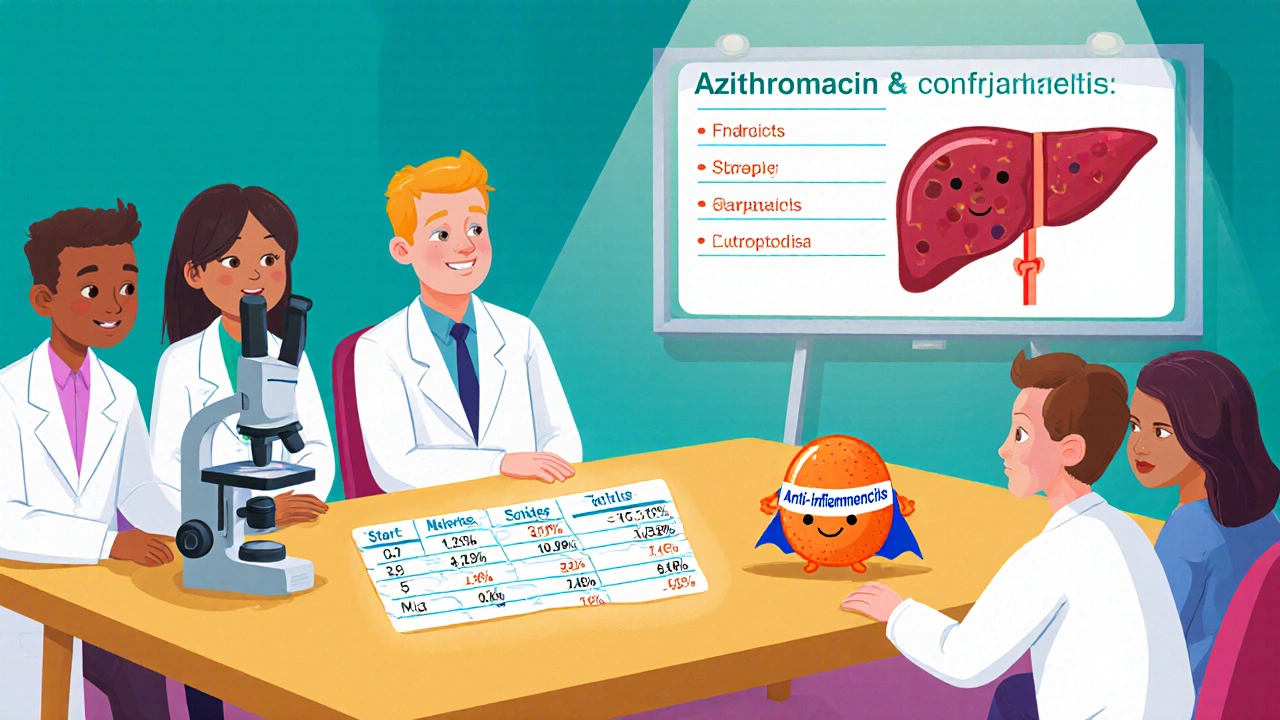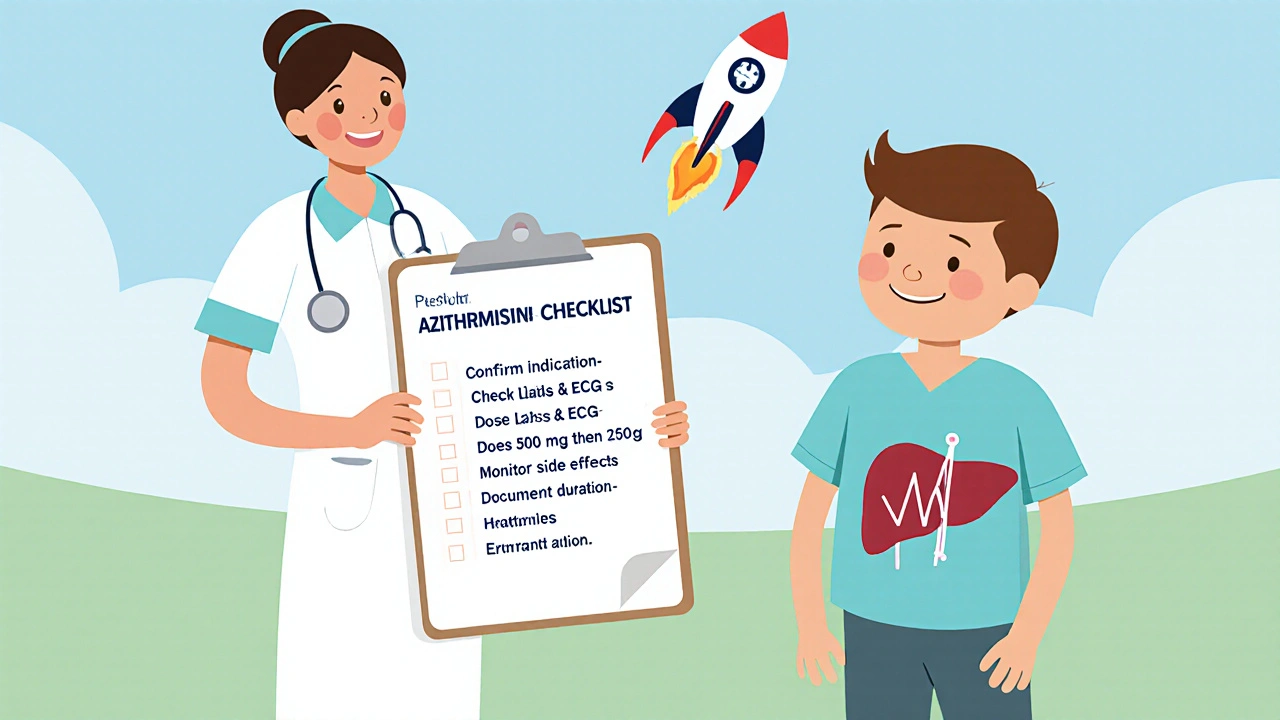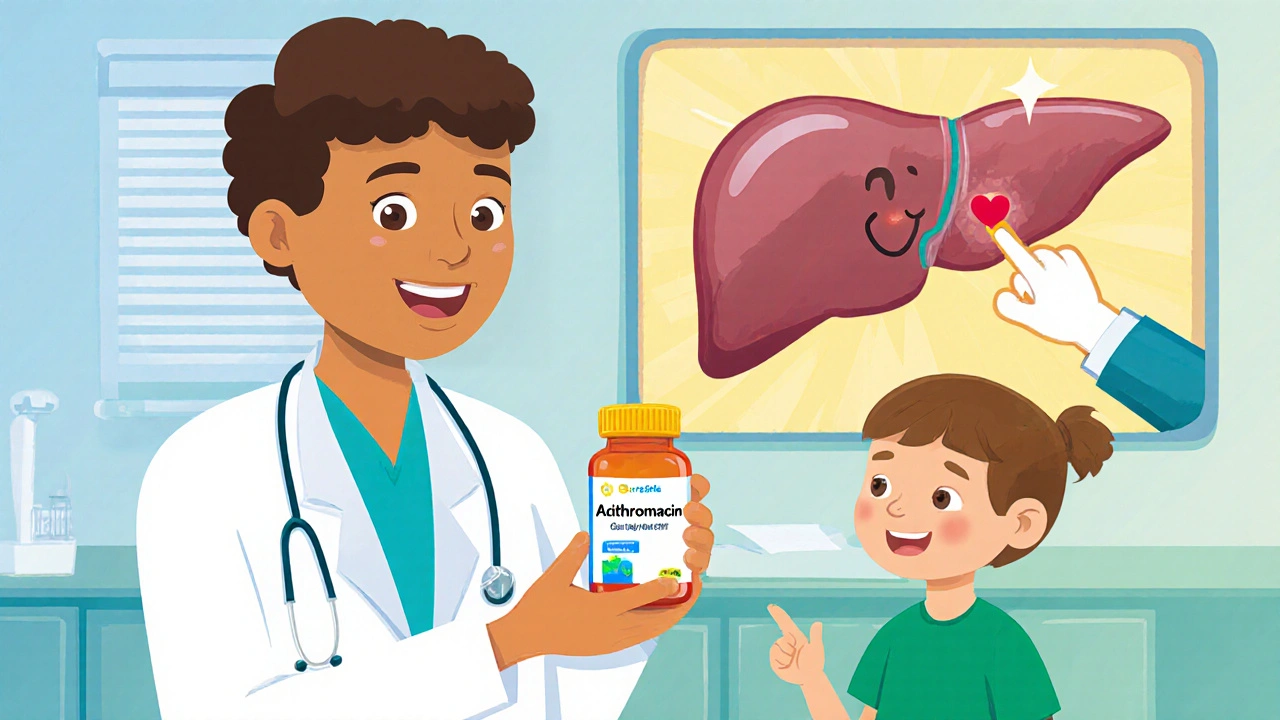Azithromycin Hepatitis Dosing Calculator
Patient Information
Recommended Dosing
Important Considerations
- Max 5 days total course to minimize antimicrobial resistance
- Monitor LFTs after 1 week of treatment
- Avoid with other QT-prolonging medications
Clinical Alert
When doctors talk about fighting hepatitis, antibiotics aren’t the first thing that comes to mind-antivirals usually steal the spotlight. Yet azithromycin has popped up in a handful of studies and off‑label discussions, especially for certain viral strains and complications. This article walks you through what the drug actually does, why some clinicians consider it for hepatitis, the solid data behind the idea, and the safety red flags you should watch for.
What Is Azithromycin?
Azithromycin is a macrolide antibiotic that works by inhibiting bacterial protein synthesis, effectively stopping many gram‑positive and some gram‑negative bacteria from growing. First approved by the FDA in 1991, it’s best known for treating respiratory infections, skin infections, and sexually transmitted diseases. Its long half‑life (about 68 hours) lets doctors prescribe a short three‑day course for conditions that would otherwise need a week or more of therapy.
Understanding Hepatitis
Hepatitis describes inflammation of the liver, most commonly caused by viral infections such as hepatitis A, B, C, D, and E. While hepatitis A and E usually resolve on their own, hepatitis B and C can become chronic, leading to cirrhosis or liver cancer. The core problem is viral replication inside liver cells, which is why standard treatment revolves around antiviral drugs like Sofosbuvir and Ribavirin.
Why Would a Doctor Consider Azithromycin for Hepatitis?
- Anti‑inflammatory properties: Beyond killing bacteria, azithromycin dampens certain cytokine pathways, which could theoretically reduce liver inflammation caused by viral infection.
- Immunomodulation: The drug influences the activity of immune cells like macrophages and T‑lymphocytes. Some researchers think this effect might help the body control viral load indirectly.
- Prevention of bacterial superinfection: Hepatitis patients, especially those with cirrhosis, are prone to bacterial peritonitis. Adding an antibiotic could guard against that secondary threat.
These ideas sound promising, but they need hard data before becoming routine practice.
Clinical Evidence: What the Studies Say
Only a few well‑designed trials have examined azithromycin in the context of hepatitis. Below is a quick snapshot of the most cited research.
| Study | Design | Population | Outcome | Safety Notes |
|---|---|---|---|---|
| Kim et al., 2022 | Randomized, double‑blind, placebo‑controlled | 120 chronic hepatitis C patients on sofosbuvir‑based regimen | Added azithromycin reduced ALT levels by 15 % vs placebo (p=0.03) | 2 % reported mild GI upset; no hepatic decompensation |
| Alvarez et al., 2021 | Observational cohort | 85 hepatitis B cirrhotics receiving standard antivirals | Azithromycin prophylaxis lowered bacterial peritonitis incidence from 12 % to 4 % | One case of QT prolongation, resolved after discontinuation |
| WHO Pilot, 2020 | Open‑label pilot | 40 acute hepatitis A cases with severe jaundice | No difference in viral clearance time; trend toward faster symptom relief | No serious adverse events; mild rash in 5 % |
Overall, the data hint at modest anti‑inflammatory benefits and a protective role against bacterial complications, but they stop short of showing a direct antiviral effect. Moreover, most trials involved azithromycin as an adjunct, not a standalone therapy.

Potential Risks and Contra‑indications
Azithromycin is generally safe, yet liver‑impaired patients need extra caution. Here are the main red flags:
- Hepatotoxicity: Rare cases of drug‑induced liver injury have been reported, especially when combined with other hepatotoxic meds.
- QT prolongation: The antibiotic can affect heart rhythm. Patients with existing arrhythmias or who take other QT‑prolonging drugs (e.g., certain antihistamines) should be monitored.
- Antimicrobial resistance: Overuse of macrolides fuels resistance in pathogens like Streptococcus pneumoniae. This is a public‑health concern, so prescribing should be justified.
- Drug interactions: Azithromycin inhibits CYP3A4 modestly, which can raise levels of certain antivirals or statins.
Because of these factors, most hepatology societies only recommend azithromycin for specific scenarios-like prophylaxis against spontaneous bacterial peritonitis in cirrhotic patients-not for treating the viral infection itself.
Practical Guidelines for Clinicians
If you’re a prescriber thinking about adding azithromycin to a hepatitis regimen, follow these steps:
- Confirm the indication. Use azithromycin only for documented bacterial superinfection risk or as an adjunct anti‑inflammatory agent in a clinical trial setting.
- Check baseline labs. Get liver function tests (ALT, AST, bilirubin) and ECG to assess QT interval.
- Choose the right dose. The typical hepatic dosing is 500 mg on day 1, then 250 mg daily for the next four days. Adjust for severe hepatic impairment (Child‑Pugh C) by halving the dose.
- Monitor for side effects. Re‑check labs after one week; watch for jaundice worsening, cardiac symptoms, or signs of allergic reaction.
- Document duration. Limit therapy to the shortest effective course-usually five days-to curb resistance.
Documenting the rationale in the patient’s chart helps with future audits and insurance approvals.
Future Directions: Where Research Is Heading
Scientists are now looking at azithromycin’s role in modulating the gut‑liver axis. Early animal models suggest that the drug may shift gut microbiota toward less endotoxin‑producing strains, indirectly easing liver inflammation. Large‑scale phase III trials are slated to start in 2026, focusing on chronic hepatitis C patients who have failed standard antiviral therapy.
Until those results arrive, the consensus remains: azithromycin can be a useful adjunct in selected hepatitis cases, but it isn’t a substitute for proven antivirals.
Can azithromycin cure hepatitis?
No. Azithromycin does not directly target the hepatitis viruses. It may reduce inflammation or prevent bacterial infections, but antiviral therapy remains essential for cure.

Is azithromycin safe for patients with liver cirrhosis?
Generally yes, if dosed correctly and monitored. The drug can cause rare liver injury, so clinicians should check liver enzymes before and during treatment.
What dose of azithromycin is recommended for hepatitis patients?
A common regimen is 500 mg on day 1 followed by 250 mg daily for four more days. Dose reductions are needed for severe hepatic impairment.
Does azithromycin interact with common hepatitis antivirals?
It has a mild effect on CYP3A4, which can raise levels of some antivirals like glecaprevir/pibrentasvir. Checking drug‑interaction databases is advised.
Should I take azithromycin if I have chronic hepatitis B?
Only if your doctor has identified a specific bacterial risk or enrolled you in a study. It does not replace nucleos(t)ide analogues like tenofovir.


In clinical practice, adding azithromycin as an adjunct can be justified when bacterial superinfection risk is documented. The guidelines suggest confirming liver function and ECG before initiation. Monitoring labs after the first week helps ensure safety. Always document the rationale to satisfy audit requirements.
Azithromycin’s anti‑inflammatory effect may modestly reduce ALT levels, but it does not replace antiviral therapy.
Check the QT interval before prescribing azithromycin and repeat if the patient is on other QT‑prolonging drugs. It’s also wise to adjust the dose in Child‑Pugh C patients.
Prescribing a broad‑spectrum macrolide without a clear bacterial indication is ethically dubious. It fuels resistance and undermines stewardship.
I understand the concern about liver safety, and careful lab monitoring can mitigate many risks. Patients often appreciate the added protection against peritonitis when they’re informed.
Short course, proper dosing.
Resistance patterns are a global issue, not a local anomaly.